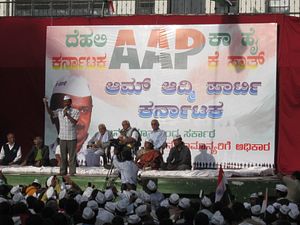The unexpected win of the Aam Aadmi Party (AAP) in the Delhi State Assembly elections had its roots in the massive use of new media accessed from mobile phones to form a political party and build an electoral campaign in a very short span of time. The record voter turnout was in contrast to falling turnouts in other elections in recent years. AAP’s online team claim to have reached more than 3 million voters with an app called Thunderclap that got out the vote on polling day.
Low voter turnout has emerged as a fundamental threat to India’s democracy. In 2012, the former chief election commissioner of India S.Y. Quraishi observed, “If 30 per cent of people vote and one of them wins with 12 per cent of that, both the quality of the representation and the legitimacy of governance will suffer.”
Over the years, the Election Commission of India has made several attempts to increase turnout, including the appointment of community-based booth liaison officers, hand-delivery of voter slips prior to the election day and the running of awareness campaigns in the media. Nevertheless, the decline has been irreversible. Voters in urban areas remain apathetic. They complain about the pervasive corruption, lack of governance, and callous representatives but don’t turn up at the polling booth on election day. Except for the recent Delhi State Assembly elections, that is.
India now has more than 900 million mobile phones in use, with density in urban areas reaching 138 percent. It has been estimated that at some point in the next few years every Indian will own a mobile phone. With their near universal availability, mobile phones are increasingly being used for banking, healthcare, payments, fundraising, radio, television and social media. The Internet and Mobile Association of India says that 185 million Indians will access the internet through their mobile phones by June this year.
Mobile phones are already a trusted medium for financial transactions in India. More than seven billion transactions were concluded via mobile banking last year. In 2011, the Reserve Bank of India removed the ceiling of Rs 50,000 ($817) per customer per day and allowed banks to set transaction limits based on their own risk perception. The decision was taken because rapid developments in mobile technology instilled confidence in mobile transactions.
A number of countries have introduced electronic voting as an option for casting votes together with traditional paper ballots. Estonia has allowed e-voting since 2005, making it the first country in the world to do so. The mobile operator EMT has created the world’s first mobile identification service in Estonia, making it possible to vote via mobile phone. In the 2011 parliamentary elections, about 25 percent of Estonians voted via the internet. Independent security audits have found the Estonian system effective and reliable.
India, the world’s largest democracy, has been a pioneer in introducing new and innovative technologies for casting votes. Electronic Voting Machines (EVMs) were devised and designed by the Election Commission of India in collaboration with two private sector firms. Several countries have purchased them for their own use.
Gujrat was the first Indian state to experiment with internet voting and the Bihar Election Commission will introduce e-voting in the next urban bodies polls. The time would seem to be right for the Election Commission of India to trial e-voting in large urban centers, giving urban voters the chance to vote from the comfort of their mobile phones. This would not only bring the Indian middle class back into the democratic process; it could potentially transform the country’s electoral landscape.
Mobile phones and the new media are already changing the way election campaigns are conducted and funds are raised. Micro-donations be made with only an SMS, revolutionizing election funding in India. AAP’s volunteers claim they collected roughly $1.8 million for the Delhi State Assembly campaign using mobile phones and social media.
Major Indian political parties are already making extensive use of social networking sites such as Facebook, Twitter and YouTube, and are engaging in brand advertising online with the launch of Android, Nokia, Blackberry and iPhone apps designed to win the hearts and minds of the younger generation. This has reduced campaign costs while also preserving the environment. As for the effectiveness of this new approach, the AAP is proof of that.
Abhay K. is an award-winning poet-diplomat. The views expressed here are his own.

































